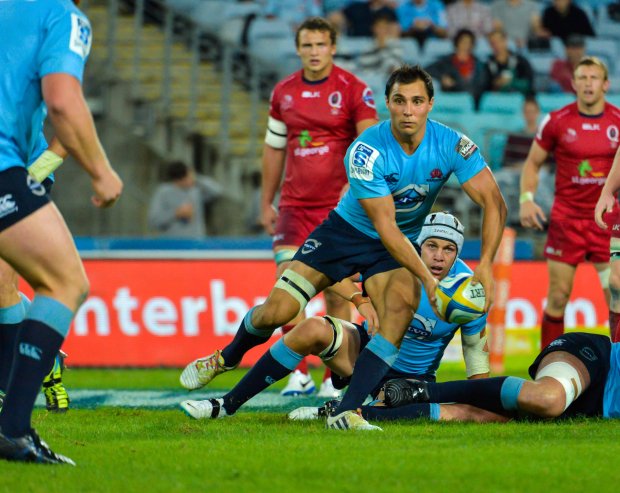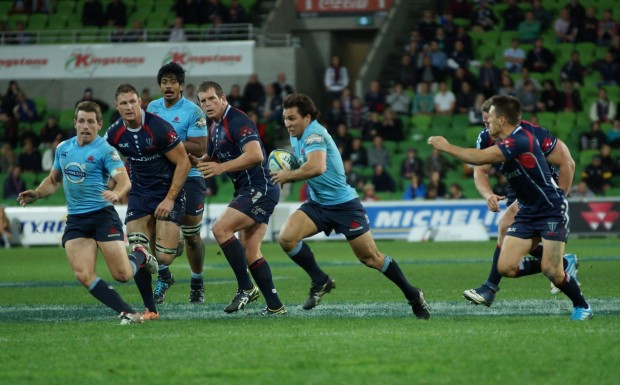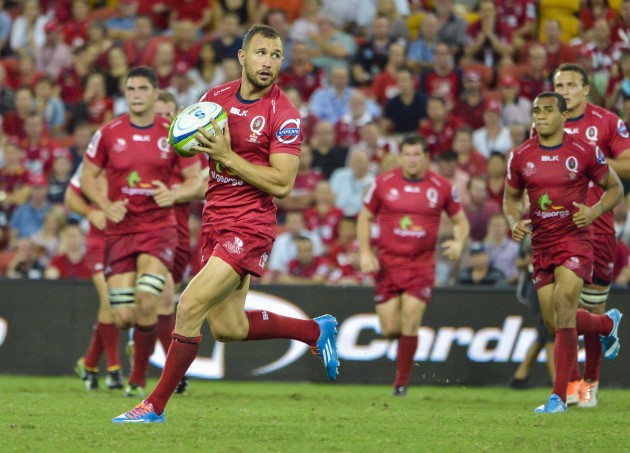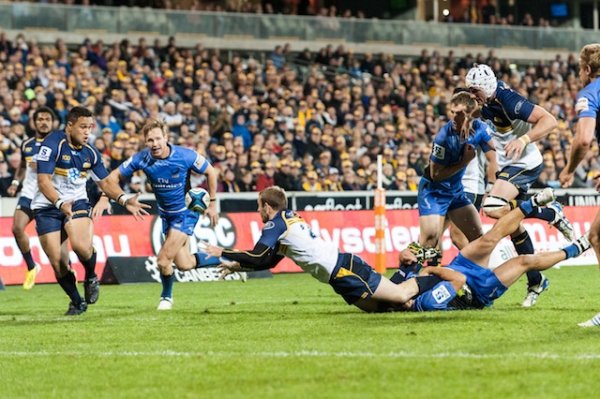When I played and then when I was a young coach, an old player and old coach – also a famous wallaby and Waratah, Cyril Towers – tried to teach a difficult young player/coach about rugby.
Cyril used to say a few things about the nine and ten position. The first was that the scrum half should “tack himself onto the ball”. He also said that it wasn’t important about how long the scrum half’s pass was – it was about how soon between when the ball was available and when it was in the fly half’s hand.
So the scrum half has to be available the instant the ball is. He needs to chase the ball constantly. It’s not so much his pace (although that may come in handy) but his focus on that as a vital part of his game. If a scrum half passes and rocks back onto his back foot he loses two metres in his chase. If he passes and rocks forward he’s instantly on his way.
It is possible for too quick not to be good; too directly behind the pack and you can get in the way of their breakdown work.
But this timing is vital. I therefore don’t want to pick any scrum half who’s not 99 out of 100 times directly behind the forward pack. And I don’t want to pick a scrum half where there’s a significant amount of time between when the ball’s available and when it’s in the first receiver’s hand.
In one of the Waratahs tries on Friday night Nick Phipps was stretched because the ball became available very quickly. He picked up the ball with one hand and scooted. By doing this immediately, he threatened the defence which was still folding, and eventually resulted in a try. If the scrum half is intent on being there every time, when the opportunity presents itself, he can take advantage of it. It’s not that you position yourself to take certain opportunities, you present yourself to take advantage of ANY opportunity.
Catchpole was the prince of this and Nick Farr-Jones was excellent. Early in my association with Nick he asked me how he was playing. I said he was doing well. He said – you think I can be doing better, don’t you? I said – well, yes (but then just about everyone can do better). He said – that’s because you think I could be faster to the ball don’t you? I replied in the affirmative. Nick then revealed that earlier in his grade career Uni weren’t a great side and he found the need to cover a few different positions, like fullback.

Therein lies a story, because if each of the individuals don’t perform their role – part of a mosaic, then you can’t complete the mosaic.
Nine is a real problem for the Wallabies – Genia has all of the overlay: strong, fast, courageous, takes the high ball and kicks not too badly, but the fundamentals are wrong. Nic White has real qualities but seems to get too agitated at times for me and it puts him off his game. Nic does have the best pass of the three nines in the squad though, with a kicking game to boot. The French don’t have a problem with scrum halves being goal kickers, I don’t see why the Wallabies should.
Onto fly-half. Cyril used to describe the scrum half as a restricted position because if he overplayed that role he would take way from players outside of him the opportunity for them to perform their role. He described fly half as a semi-restricted role – if he didn’t restrict the width of the field in which he would carry the ball, he would assist the opposition defence and restrict what those outside him could do.
In my experience, those who are very good with the ball – agile, quick runners and who also have the need to do that as part of their performance don’t make good players close to the scrum. Nines who want to run too much don’t make good scrum-halves. Fly halves who want to run too much or have the psychological need to throw the miracle pass will similarly not do well if the fundamentals aren’t there.
At his best I liked Quade Cooper because he could do both – attack the line tight and support. The overlay was the amazing footwork and neuromuscular response he had which was like greased lightening. In more recent times the fundamentals have gone completely. Sometimes he doesn’t attack the line at all, he runs across the pitch and he never gets a second touch any more because his support lines are bad.
Equally I don’t like Kurtley at fly half because he has to play with the ball in his hands. The part of the game where he doesn’t have the ball doesn’t excite him. What excites him is his brilliant running skills, acceleration and pace. It appears to me that Ewen wants to play him at fly half and I wouldn’t do that. I’ve always thought Kurtley can play 13 and beyond.
For maximum result for the team I want to pick people who first of all understand their role perfectly and can execute it. The fly-half’s role is to give the opposition seven a sniff of him and make the opposition ten think I’m not sure the seven can get to him and ‘I need to be here’. I want that 10 to think ‘this guy is dangerous’.
A long time ago the prince of fly halves in Europe (and maybe the world) was Jackie Kyle from Ireland and the young pretender was Cliff Morgan from Wales, who at a Barbarian lunch once told the tale a about playing Kyle in Morgan’s first season. To start with, Cliff stayed on Kyle so much that by the end of the first half he thought there isn’t so much about this Kyle guy. Early in the second half Morgan then drifted off Kyle to watch a threat from the midfield. When Cliff next turned around Kyle was dotting down under the posts.
For me Toomua is this player. I see absolutely no weaknesses in him at all, and he gets second touches – the mark of playing well. By the way I’d even call the one hand pick up from Phipps a second touch – it’s practically a loop play.
The Wallabies seem worried about not having a ball distributor at inside centre – as I am. But the prime roles of the scrum half and fly halves I’ve described must happen first.
While Toomua is solid, I would want a bigger bloke at twelve – either Kuridrani or McCabe – the latter of whom’s development this season has been astronomical and I put this down to Stephen Larkham. He threatens every time he comes off the bench. What I love about these guys (and Adam Ashley-Cooper) is that they can all take a little inside shoulder.
A quick note on the Tahs performance. Six tries against the Rebels in Melbourne has to be a satisfying night out. How many have done that this year? With the ball in hand I would describe the Tahs as relentless – they absolutely give you a pounding and they have real ability to score tries. They’re a very good side. But I’m a hard task master which was drilled into me when one of my teams scored 99 tries in 20 matches. I asked Cyril what he thought and he said he thought we were terrible!
I think the Waratahs could be a great side, and all they need to add to their repertoire is accuracy to what they do – of passing and support lines – as it could be much improved. Whenever you see an opportunity and the ball goes two metres behind the player – that’s just inexcusable. Just as unacceptable is the receiver running and not be ready to catch the pass.
With this accuracy and a better performing scrum, the Tahs aren’t far off a great side.





